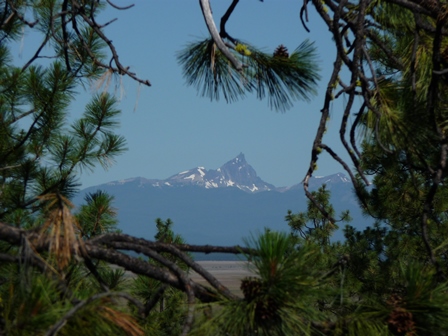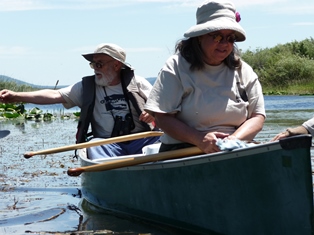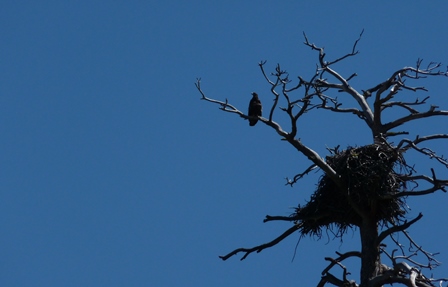
by Mary Van
Water defines Oregon. Water is life for an antelope in the Alvord desert; water is death for the unwary crossing the Columbia bar. Water carved the gorge. The majority of Oregonians live on the “wet side” but water runs through the east side as well. It is there, in the Klamath Marsh, that Wendell and Kathy Wood led a motley group of visitors in their kayaks and canoes. The Wood’s give of their time, money, and home to offer total strangers a chance to fall in love with the wild left in Oregon.
The Klamath Basin was once spanned by 185,000 acres of shallow lakes and marshes supporting an estimated 20 million migratory birds on a major flyway that constricts to funnel them into this one spot.
Since the industrial age began, the waterways of the Klamath Basin have shrunk to 46,000 acres supporting 2 million birds representing over 400 species. The water continues to disappear as it is used for other purposes, and consequently, the bird numbers continue to decline.
 Wendell Wood, a naturalist with Oregon Wild, watches the marshes dry. He hopes that if Oregonians experience the marsh – the eagles and the ibis, the otters and the ermine – the people of Oregon might leave a place for them, might even love them, and be willing to save them.
Wendell Wood, a naturalist with Oregon Wild, watches the marshes dry. He hopes that if Oregonians experience the marsh – the eagles and the ibis, the otters and the ermine – the people of Oregon might leave a place for them, might even love them, and be willing to save them.
They huddled in the middle of the road against the body of their mother. It was morning of the second day of our trip and we were traveling to the Williamson River for a day of paddling when we saw the otters. Wendell Wood moved the mother’s body off the road and down to the water. Her body was stiff. The small otters had stayed with her body in the middle of the road for hours. How would they learn to eat, shelter, or survive without their mother?
The pups clung to each other, crying soft mournful sounds, pieces of asphalt clinging to their fur. Before we could catch them to even determine if wildlife rehabilitation was available, they ran down to the water and whatever fate was waiting.
It was small death, but what does it mean for our state, when the first wild otter someone sees is dead, and the next two adorable siblings are not expected to survive the week?
 We drove onto the Williamson River. The small section of river the group paddled hosted two bald eagle nests with ample opportunity to view mature and immature bald eagles, as well as egrets, ibis, cormorants, beaver, short eared owl, sapsuckers, woodpeckers, tree frogs, trout and a host of plants from spirea covered in brilliant pink flowers to yellow monkey flowers and the ubiquitous blue spikes of lupine.
We drove onto the Williamson River. The small section of river the group paddled hosted two bald eagle nests with ample opportunity to view mature and immature bald eagles, as well as egrets, ibis, cormorants, beaver, short eared owl, sapsuckers, woodpeckers, tree frogs, trout and a host of plants from spirea covered in brilliant pink flowers to yellow monkey flowers and the ubiquitous blue spikes of lupine.
In a kayak, gliding across the water is peace. The quiet is broken by the call of a lonely male chipping sparrow looking for love. The stillness displaced by the powerful takeoff of a bald eagle. It was an amazing morning of big and little miracles. By the afternoon, in the heat, the stillness became immense, heavy, not just something to be paddled through, but something that could be touched.
A scream to the left, a red-tailed hawk dove out of a Ponderosa pine, a female mallard running, flapping, paddling, terrified, she crossed in front of the kayak. Her life existed only in the fraction of a second that existed between her body and the talons of the hawk. Screaming in the language of ducks, she made it into the air and then to the safety of the bushes.
The hawk cast a disgusted look at me and took off. In that spot of near disaster, I pulled up for lunch. Minutes later a duckling shot across the water from nearly under my feet. A minute later, a second duckling followed. The first duckling made it to the brush on the far side of the river, when the second duckling, in the middle of the river, disappeared. Was the duckling consumed by a fish or a turtle?
A few minutes after, the female mallard returned. She called out in a soft voice. Swimming past she collected a duckling that had stayed, then she moved across the river, still calling softly. The first duckling swam out to meet his mother. Three hooded mergansers floated by, the denizens of this section of river. The hawk cried out in the distance. Suddenly, the duckling that had disappeared in the midst of the river, reappeared out of brush that it had swam underwater to and rushed to catch up with its family.
And this was just one morning of a three-day kayaking adventure, open to anyone and hosted by Oregon Wild and the kindness of Wendell and Kathy Wood.
So, in one morning there was death, there was life, and there was Oregon wild.
Written by Mary Van (7.26.14) Transposed by Christie Moore.
 '
'
